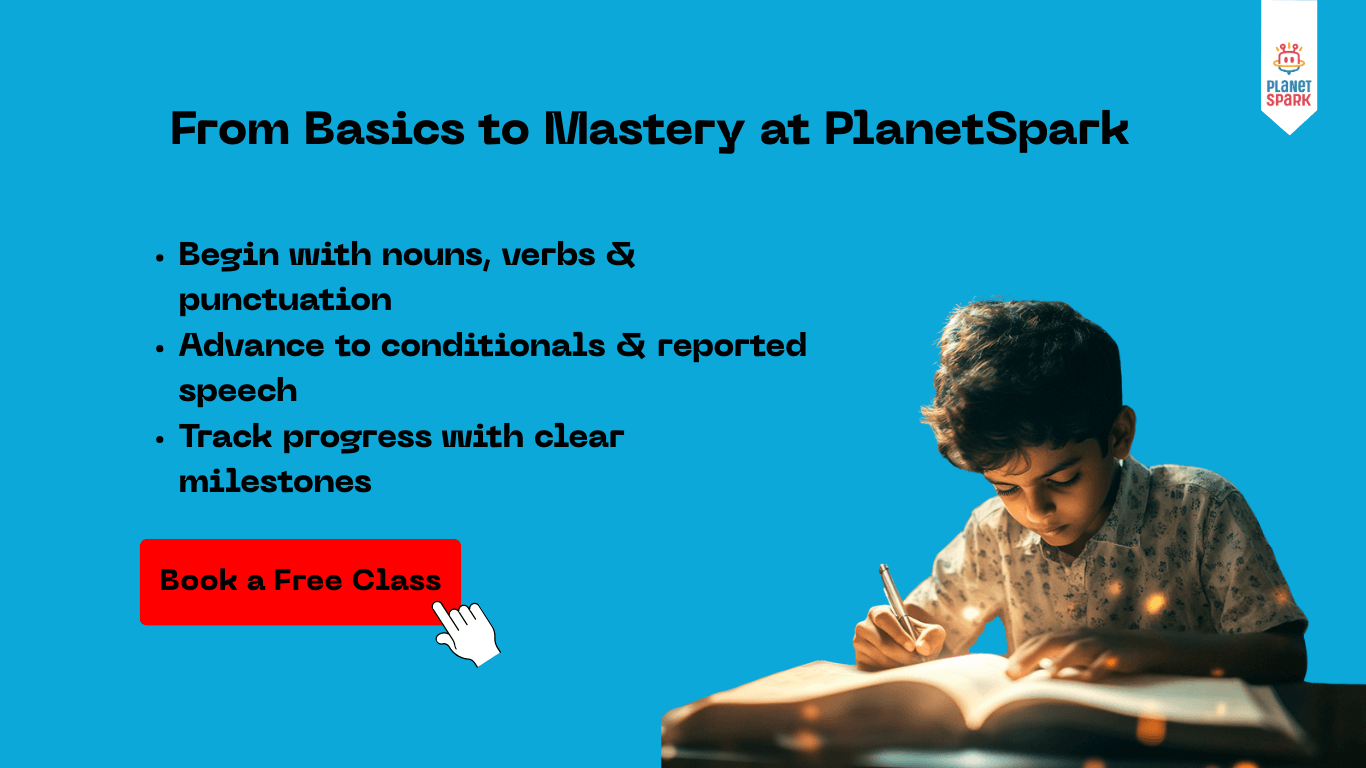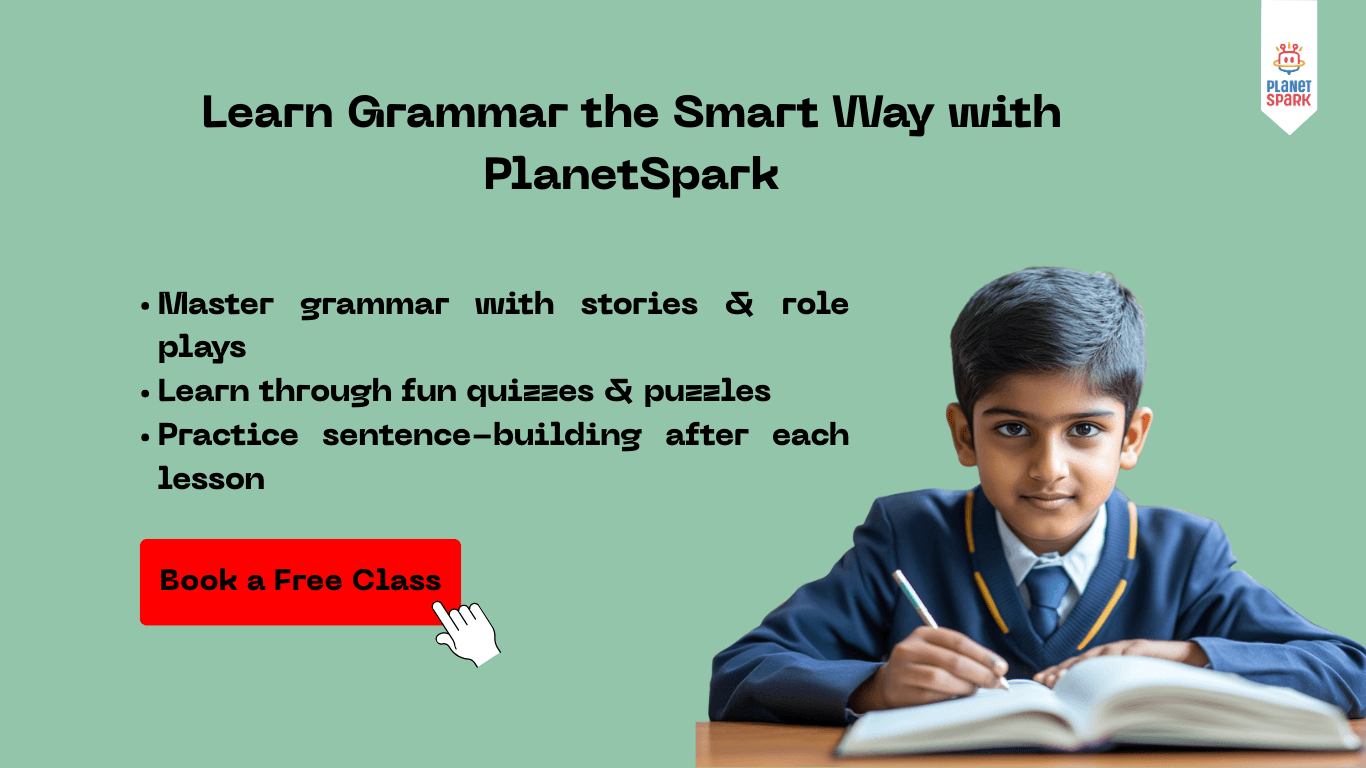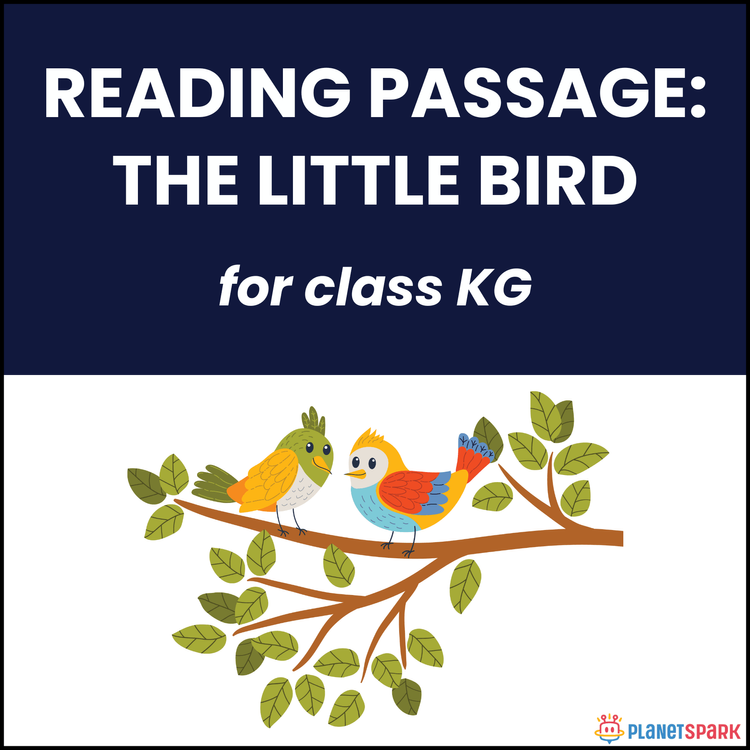100 Examples Showing Active vs Passive Voice in Sentences

Table of Contents
- What is Active and Passive Voice?
- 100 Active and Passive Voice Examples
- Active and Passive Voice Rules
- Differences Between Active and Passive Voice
- How to Teach or Learn Active and Passive Voice
- Active and Passive Voice Worksheet with Answers
- Master English Grammar Course with PlanetSpark
- Inspiring Your Child’s Language Journey
Understanding Active and Passive Voice is a vital skill for young learners to communicate clearly and confidently in English. This grammar concept helps students express actions from different perspectives, enhancing both their writing and speaking abilities.
In this blog, discover clear definitions, essential rules, 100 examples, and useful worksheets,all designed to help parents, students, and educators confidently navigate this important topic.
👉Empower your child with strong English skills! Book a free demo now
What is Active and Passive Voice?
Active voice emphasizes the subject performing the action, while passive voice highlights the action itself or the receiver of the action. Understanding this distinction helps children write clear, concise, and impactful sentences, crucial for school assignments, storytelling, and presentations.
Examples:
Active: The cat chased the mouse.
Passive: The mouse was chased by the cat.

100 Active and Passive Voice Examples
1. Simple Present Tense
Active: She reads a book.
Passive: A book is read by her.
Active: The children play football.
Passive: Football is played by the children.
Active: He writes a letter.
Passive: A letter is written by him.
Active: They clean the classroom.
Passive: The classroom is cleaned by them.
Active: The cat chases the mouse.
Passive: The mouse is chased by the cat.
Active: She makes a cake.
Passive: A cake is made by her.
Active: The teacher explains the lesson.
Passive: The lesson is explained by the teacher.
Active: Birds eat seeds.
Passive: Seeds are eaten by birds.
Active: I watch TV every day.
Passive: TV is watched by me every day.
Active: He waters the plants.
Passive: The plants are watered by him.
2. Present Continuous Tense
Active: She is reading a book.
Passive: A book is being read by her.
Active: They are painting the wall.
Passive: The wall is being painted by them.
Active: He is writing an email.
Passive: An email is being written by him.
Active: The children are cleaning the room.
Passive: The room is being cleaned by the children.
Active: The dog is chasing the cat.
Passive: The cat is being chased by the dog.
Active: She is making a dress.
Passive: A dress is being made by her.
Active: They are playing football.
Passive: Football is being played by them.
Active: The teacher is explaining the lesson.
Passive: The lesson is being explained by the teacher.
Active: He is cooking dinner.
Passive: Dinner is being cooked by him.
Active: I am cleaning my room.
Passive: My room is being cleaned by me.
3. Simple Past Tense
Active: The chef cooked a delicious meal.
Passive: A delicious meal was cooked by the chef.
Active: She wrote a letter.
Passive: A letter was written by her.
Active: They built a house.
Passive: A house was built by them.
Active: He painted the wall.
Passive: The wall was painted by him.
Active: The students completed the project.
Passive: The project was completed by the students.
Active: I saw a movie yesterday.
Passive: A movie was seen by me yesterday.
Active: She helped her friend.
Passive: Her friend was helped by her.
Active: The police caught the thief.
Passive: The thief was caught by the police.
Active: They sold their car.
Passive: Their car was sold by them.
Active: He repaired the bike.
Passive: The bike was repaired by him.
4. Past Continuous Tense
Active: She was reading a book.
Passive: A book was being read by her.
Active: They were cleaning the room.
Passive: The room was being cleaned by them.
Active: He was writing an email.
Passive: An email was being written by him.
Active: The students were solving the problem.
Passive: The problem was being solved by the students.
Active: She was baking a cake.
Passive: A cake was being baked by her.
Active: The dog was chasing the cat.
Passive: The cat was being chased by the dog.
Active: He was painting the wall.
Passive: The wall was being painted by him.
Active: They were playing football.
Passive: Football was being played by them.
Active: I was cleaning the house.
Passive: The house was being cleaned by me.
Active: She was helping her friend.
Passive: Her friend was being helped by her.
5. Simple Future Tense
Active: They will complete the project tomorrow.
Passive: The project will be completed by them tomorrow.
Active: She will write a letter.
Passive: A letter will be written by her.
Active: He will cook dinner tonight.
Passive: Dinner will be cooked by him tonight.
Active: The students will submit the homework.
Passive: The homework will be submitted by the students.
Active: I will read this book.
Passive: This book will be read by me.
Active: They will clean the classroom.
Passive: The classroom will be cleaned by them.
Active: She will make a cake.
Passive: A cake will be made by her.
Active: He will repair the car.
Passive: The car will be repaired by him.
Active: The teacher will explain the lesson.
Passive: The lesson will be explained by the teacher.
Active: We will plant trees.
Passive: Trees will be planted by us.
👉Ready to boost your child’s grammar? Book a free PlanetSpark demo today!
6. Future Continuous Tense
Active: She will be reading a book.
Passive: A book will be being read by her.
Active: They will be painting the walls.
Passive: The walls will be being painted by them.
Active: He will be writing a report.
Passive: A report will be written by him.
Active: The students will be solving the problem.
Passive: The problem will be being solved by the students.
Active: She will be baking a cake.
Passive: A cake will be baked by her.
Active: I will be cleaning the house.
Passive: The house will be being cleaned by me.
Active: He will be repairing the bike.
Passive: The bike will be being repaired by him.
Active: They will be playing football.
Passive: Football will be being played by them.
Active: She will be helping her friend.
Passive: Her friend will be being helped by her.
Active: The teacher will be explaining the lesson.
Passive: The lesson will be being explained by the teacher.
7. Present Perfect Tense
Active: She has written a letter.
Passive: A letter has been written by her.
Active: They have completed the project.
Passive: The project has been completed by them.
Active: He has repaired the car.
Passive: The car has been repaired by him.
Active: I have read this book.
Passive: This book has been read by me.
Active: The teacher has explained the lesson.
Passive: The lesson has been explained by the teacher.
Active: She has baked a cake.
Passive: A cake has been baked by her.
Active: They have cleaned the room.
Passive: The room has been cleaned by them.
Active: He has painted the wall.
Passive: The wall has been painted by him.
Active: The dog has chased the cat.
Passive: The cat has been chased by the dog.
Active: I have completed my homework.
Passive: My homework has been completed by me.
8. Past Perfect Tense
Active: She had written the letter.
Passive: The letter had been written by her.
Active: They had completed the project.
Passive: The project had been completed by them.
Active: He had repaired the car.
Passive: The car had been repaired by him.
Active: I had read the book.
Passive: The book had been read by me.
Active: The teacher had explained the lesson.
Passive: The lesson had been explained by the teacher.
Active: She had baked a cake.
Passive: A cake had been baked by her.
Active: They had cleaned the room.
Passive: The room had been cleaned by them.
Active: He had painted the wall.
Passive: The wall had been painted by him.
Active: The dog had chased the cat.
Passive: The cat had been chased by the dog.
Active: I had completed my homework.
Passive: My homework had been completed by me.
9. Future Perfect Tense
Active: She will have written the letter by tomorrow.
Passive: The letter will have been written by her by tomorrow.
Active: They will have completed the project.
Passive: The project will have been completed by them.
Active: He will have repaired the car.
Passive: The car will have been repaired by him.
Active: I will have read the book.
Passive: The book will have been read by me.
Active: The teacher will have explained the lesson.
Passive: The lesson will have been explained by the teacher.
Active: She will have baked a cake.
Passive: A cake will have been baked by her.
Active: They will have cleaned the room.
Passive: The room will have been cleaned by them.
Active: He will have painted the wall.
Passive: The wall will have been painted by him.
Active: The dog will have chased the cat.
Passive: The cat will have been chased by the dog.
Active: I will have completed my homework.
Passive: My homework will have been completed by me.
10. Miscellaneous / Modal Verbs
Active: She can write a letter.
Passive: A letter can be written by her.
Active: They should complete the project.
Passive: The project should be completed by them.
Active: He must repair the car.
Passive: The car must be repaired by him.
Active: I may read this book.
Passive: This book may be read by me.
Active: She might bake a cake.
Passive: A cake might be baked by her.
Active: They could clean the room.
Passive: The room could be cleaned by them.
Active: He will be able to solve the problem.
Passive: The problem will be able to be solved by him.
Active: We can plant trees.
Passive: Trees can be planted by us.
Active: She shall complete the assignment.
Passive: The assignment shall be completed by her.
Active: The teacher may explain the lesson.
Passive: The lesson may be explained by the teacher.

Active and Passive Voice Rules
Learning Active and Passive Voice rules ensures students know when and how to switch between voices accurately. Here are key rules:
Identify: the subject, verb, and object in a sentence.
Form: passive sentences by making the object of the active sentence the subject.
Change: the verb form: use “be + past participle” for the main verb.
Include: the original subject (optional) after “by” in the passive sentence.
Maintain: tense: the tense of the active sentence should be preserved in the passive voice.
Example:
Active: She writes a letter.
Passive: A letter is written by her.
Differences Between Active and Passive Voice
Here’s a simple table to understand the difference between Active and Passive Voice:
Understanding these differences helps children and students choose the right voice depending on the context.
How to Teach or Learn Active and Passive Voice
Step-by-Step Approach:
Start with: identifying subjects and objects.
Practice: changing sentences from active to passive and vice versa.
Use: tense charts to maintain correct verb forms.
Apply: real-life examples, like daily routines or story sentences.
Take: worksheets to test understanding.
Active and Passive Voice Worksheet with Answers
Worksheet Activities:
Change these sentences to passive voice:
Active: The dog chased the ball.
Passive: The ball was chased by the dog.Active: She sings a song.
Passive: A song is sung by her.
Convert to active voice:
Passive: The homework was completed by Raj.
Active: Raj completed the homework.Passive: The cake was baked by my mother.
Active: My mother baked the cake.
Answers:
The ball was chased by the dog.
A song is sung by her.
Raj completed the homework.
My mother baked the cake.
Practical At-Home Activities
Story Transformation: Convert sentences from storybooks into passive voice.
Daily Routine Game: Describe daily activities in active and passive forms.
Peer Exercises: Let children exchange sentences and correct each other.
Tips for Success
Start Small: Practice with simple sentences before moving to complex ones.
Maintain Tense: Ensure verb tense consistency while converting sentences.
Regular Practice: Use worksheets and daily sentence exercises.
Make it Fun: Use games, quizzes, and storytelling to practice.
Master English Grammar Course with PlanetSpark
At PlanetSpark, developing a strong grasp of English Grammar is part of a larger goal: building confident communicators ready for the modern world. Our approach goes beyond worksheets to create a rich learning environment that is engaging, practical, and personalized for every child.
We use real-life Indian examples so students see how grammar applies in their everyday conversations, stories, and schoolwork. Grammar lessons come alive through interactive sessions that feel like games, not drills, encouraging active participation. Our expert teachers provide continuous feedback, ensuring students correct mistakes early and build lasting understanding. Plus, with live group exercises, learners practice communication skills in a supportive setting drawing from familiar urban and home environments. All of this is tracked individually, so progress is clear and tailored to each child’s learning pace.

Key Features of PlanetSpark’s Learning Experience
Interactive live classes with relatable Indian contexts
Activity-driven lessons turning grammar into fun and meaningful practice
Personalized feedback from experienced educators
Digital and printable worksheets to reinforce daily learning
Collaborative group exercises fostering peer learning and confidence
Progress tracking with parent updates for ongoing support
PlanetSpark’s holistic model empowers kids not only to learn grammar but to use it confidently in school, at home, and in the real world.
Inspiring Your Child’s Language Journey
Mastering Active and Passive Voice is more than just a grammar exercise, it builds the foundation for confident, effective communication in both writing and speaking. With PlanetSpark’s personalized approach, interactive lessons, and continuous feedback, children not only understand the rules but also apply them naturally in real-life contexts. By practicing regularly, engaging with peers, and receiving guided support, students develop clarity, creativity, and confidence in English that will serve them well in school and beyond. Empower your child today to become a confident communicator and a skilled writer with PlanetSpark.
👉 Give your child the gift of confident English! Book a free PlanetSpark demo today and start transforming their language skills.
You can also read this - Active Voice and Passive Voice Rules with Examples
Frequently Asked Questions
In active voice, the subject of the sentence performs the action. For example, “The cat chased the mouse.” Here, the cat is doing the action, so the focus is on the subject. In passive voice, the focus shifts to the object receiving the action. The same sentence becomes “The mouse was chased by the cat.” Here, the action (being chased) is highlighted more than who is performing it. Active voice is often more direct and lively, while passive voice is used when the action itself is more important than the doer.
Not all sentences can be converted to passive voice. Only sentences that have a direct object (the receiver of the action) can be changed. For example, “She reads a book” can become “A book is read by her.” But sentences like “She sleeps” do not have a direct object, so they cannot be turned into passive voice. Understanding this helps students identify which sentences can be rephrased and which cannot.
Passive voice is often used in formal writing, scientific reports, and news articles because it emphasizes the action or result rather than the person doing it. For example, “The project was completed on time” focuses on the completion of the project rather than who completed it. It is also useful when the subject is unknown, unimportant, or obvious from context. This helps create variety in writing and ensures that sentences are clear and focused.
Kids can improve their understanding through fun and interactive activities:
- Worksheets: Fill-in-the-blank or matching exercises to convert sentences from active to passive and vice versa.
- Daily sentence exercises: Write 5–10 sentences every day in both active and passive forms.
- Interactive grammar games: Online quizzes, flashcards, or classroom games make practicing engaging and memorable.
- Story re-writing: Take a short story and rewrite sentences in passive voice to understand the difference.
Regular practice not only improves grammar skills but also boosts confidence in writing.
Absolutely! Mastering active and passive voice is crucial for grammar exams and academic writing. It helps students:
- Write more varied and interesting sentences.
- Improve clarity and focus in essays and reports.
- Score better in sentence correction and grammar sections.
- Communicate ideas effectively in both formal and informal writing.
By practicing these skills regularly, students can tackle questions on reported speech, writing, and comprehension more confidently.
Download Free Worksheets
Personalized Communication Report
Record a video to get a AI generated personalized communication report for your child

Hi There, want to try these
tips for your child with
LIVE with our expert coach?
Let's check your child's
English fluency



